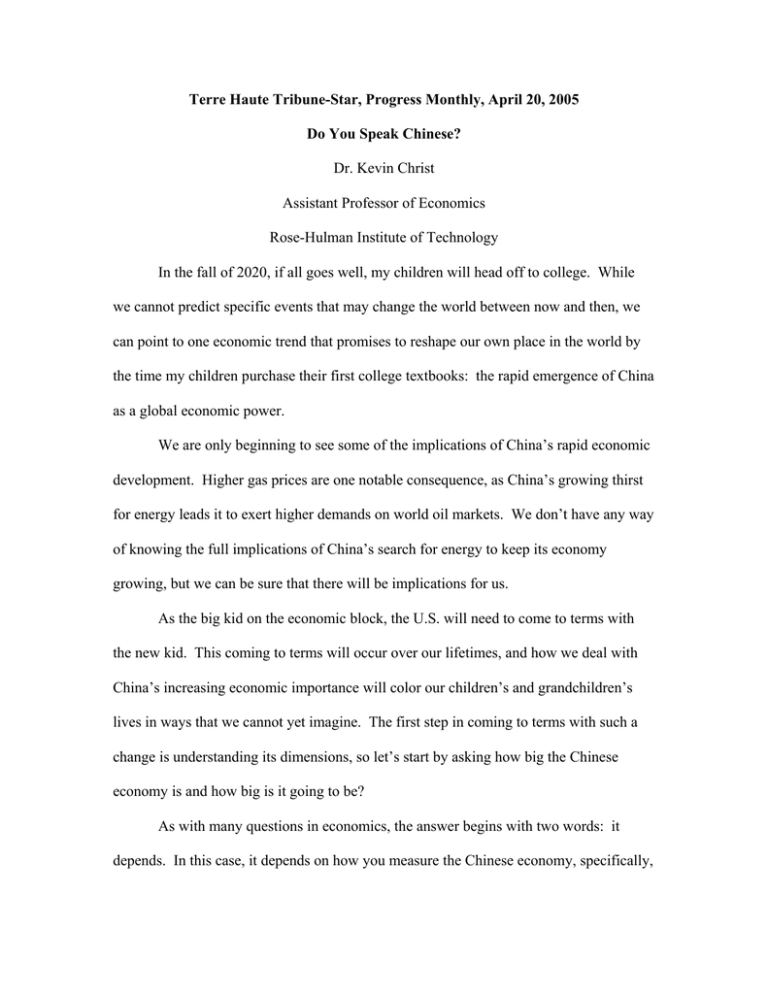Terre Haute Tribune-Star, Progress Monthly, April 20, 2005 Dr. Kevin Christ
advertisement

Terre Haute Tribune-Star, Progress Monthly, April 20, 2005 Do You Speak Chinese? Dr. Kevin Christ Assistant Professor of Economics Rose-Hulman Institute of Technology In the fall of 2020, if all goes well, my children will head off to college. While we cannot predict specific events that may change the world between now and then, we can point to one economic trend that promises to reshape our own place in the world by the time my children purchase their first college textbooks: the rapid emergence of China as a global economic power. We are only beginning to see some of the implications of China’s rapid economic development. Higher gas prices are one notable consequence, as China’s growing thirst for energy leads it to exert higher demands on world oil markets. We don’t have any way of knowing the full implications of China’s search for energy to keep its economy growing, but we can be sure that there will be implications for us. As the big kid on the economic block, the U.S. will need to come to terms with the new kid. This coming to terms will occur over our lifetimes, and how we deal with China’s increasing economic importance will color our children’s and grandchildren’s lives in ways that we cannot yet imagine. The first step in coming to terms with such a change is understanding its dimensions, so let’s start by asking how big the Chinese economy is and how big is it going to be? As with many questions in economics, the answer begins with two words: it depends. In this case, it depends on how you measure the Chinese economy, specifically, how you convert national output numbers (Gross Domestic Product or GDP) into a common currency for comparison purposes. If you take China’s reported GDP figures, and convert them to U.S. dollars at the current exchange rate, then in 2003 the Chinese economy was about one seventh the size of the U.S. economy. Exchange rates, however, can be misleading when making such comparisons because any currency exhibits different levels of purchasing power in different parts of the world. Because of this, economists use a method called “Purchasing Power Parity” (PPP) when making cross-country comparisons. The chart displays real GDP trend lines (actual and forecasted) for the U.S. and China in PPP-adjusted numbers. Using this approach, in 2003 the Chinese economy was just under one half the size of the U.S. economy, which at $11 trillion is still the world’s largest. As the table also shows, if recent growth trends continue, then by 2020 the Chinese economy would be almost as big as the U.S. economy. But what about average output, or what economists call per capita GDP? In 2003 the U.S. economy produced, in constant dollar terms, about $35,000 worth of output for every man, woman and child. In China, per capita output was somewhere between $3,000 and $4,000 (again, in PPP terms). Using this as a crude method for comparing standards of living, the average American was about nine times better off than the average Chinese in 2003. In 2020, that disparity still is likely to be about four or five times. This doesn’t mean we’ll be getting poorer as the Chinese get wealthier. It means that we’ll both be getting wealthier, but average Chinese wealth will be growing faster. Because of this, our relative position in the world is likely to change, and our children’s perception of their own place in the world may be fundamentally different from our own. It also means that we (and our children) will have to deal with the consequences of this China’s new-found economic importance. I once saw a map of the world with the size of countries distorted to reflect their relative economic size. The U.S. was huge compared to China. Over our children’s lives, that map probably will change dramatically. Are we prepared to come to terms with that reality? More importantly, are we prepared to help our children come to terms with it? U.S. and Chinese Real GDP (PPP Terms) Trillions of U.S. $ 20 15 10 U.S 5 China 0 1980 2000 2020





